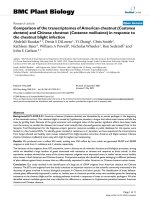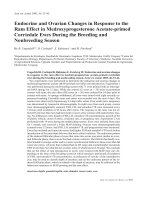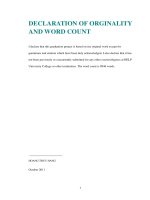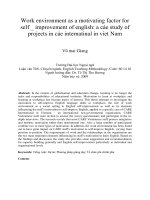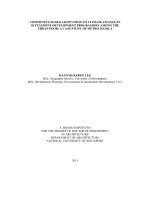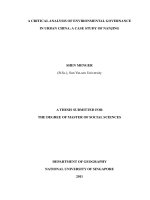Curricular change in response to the 150 hour law for CPA exam candidates, a case study of business departments at three colleges
Bạn đang xem bản rút gọn của tài liệu. Xem và tải ngay bản đầy đủ của tài liệu tại đây (13.93 MB, 236 trang )
NOTE TO USERS
Page(s) missing in number only; text follows. Page(s) were
scanned as received.
177
This reproduction is the best copy available.
®
UMI
R ep ro d u ced with p erm ission o f th e copyright ow ner. Further reproduction prohibited w ithout perm ission.
Reproduced with permission of the copyright owner. Further reproduction prohibited without permission.
CURRICULAR CHANGE IN RESPONSE TO THE 150-HOUR LAW FOR
CPA EXAM CANDIDATES: A CASE STUDY OF BUSINESS
DEPARTMENTS AT THREE COLLEGES
by
Courtney Baillie
A DISSERTATION
Presented to the Faculty of
The Graduate College at the University of Nebraska
In Partial Fulfillment of Requirements
For the Degree of Doctor of Philosophy
Major: Administration, Curriculum and Instruction
(EducationLeadership and Higher Education)
Under the Supervision of Dr. Barbara Y. LaCost
Lincoln, NE
November, 2003
R ep ro d u ced with p erm ission o f th e copyright ow ner. Further reproduction prohibited w ithout perm ission.
UMI Number: 3116560
INFORMATION TO USERS
The quality of this reproduction is dependent upon the quality of the copy
submitted. Broken or indistinct print, colored or poor quality illustrations and
photographs, print bleed-through, substandard margins, and improper
alignment can adversely affect reproduction.
In the unlikely event that the author did not send a complete manuscript
and there are missing pages, these will be noted. Also, if unauthorized
copyright material had to be removed, a note will indicate the deletion.
®
UMI
UMI Microform 3116560
Copyright 2004 by ProQuest Information and Learning Company.
All rights reserved. This microform edition is protected against
unauthorized copying under Title 17, United States Code.
ProQuest Information and Learning Company
300 North Zeeb Road
P.O. Box 1346
Ann Arbor, Ml 48106-1346
R ep ro d u ced with p erm ission o f th e copyright ow ner. Further reproduction prohibited w ithout perm ission.
DISSERTATION TITLE
C u r r ic u la r Change In R e sp o n se t o t h e 150-H ou r Law f o r CPA Exam
Cand i d a t e s :
A C ase S tu d y o f B u s i n e s s D e p a r tm e n ts a t T h ree C o l l e g e s
BY
C o u rtn ev B a l l l l e
SUPERVISORY COMMITTEE:
pproved
Date
Signature
B arb ara Y. L aC ost
Typed Name
iignafttre
M a r ily n L . Grady
Typed Name
-,P
/(y
^--------------^
Y<
,
Signature
A la n T. S e a g r e n
Typed Name
iber- a # z co 3
ignature
Jam es F . Brow n, J r
Typed Name
Signature
Typed Name
Signature
Typed Name
GRADUATE
COLLEGE
R ep ro d u ced with p erm ission of the copyright ow ner. Further reproduction prohibited w ithout perm ission.
CURRICULAR CHANGE IN RESPONSE TO THE 150-HOUR LAW FOR CPA
EXAM CANDIDATES: A CASE STUDY OF BUSINESS DEPARTMENTS OF
THREE COLLEGES
Courtney Baillie, Ph.D.
University of Nebraska, 2003
Advisor: Barbara Y. LaCost
In the early 1990’s, Iowa and Nebraska passed legislation that requires 150 hours
of higher education to be eligible to take the Uniform Certified Public Accountants
Examination. At large universities, accounting students can matriculate into Master’s of
Accounting programs to meet the requirement of the law. However, many small colleges
and universities do not offer graduate accounting degrees and need to adapt
undergraduate accounting programs to meet the requirements of the 150-Hour Law. This
process requires redesigning of curriculum by accounting faculty and department chairs.
Revised programs need to meet state specifications, as well as student expectations, for
accounting graduates to be eligible to take for the CPA exam.
The purpose of this case study was to describe the process and the issues that
emerged in the business departments of three small colleges as they adapted their
accounting programs to comply with the educational requirements of the 150-Hour Law.
The grand tour question for this case study was: How do stakeholders at three small
colleges describe the process and issues that emerge from adapting their respective
institutions’ accounting programs to comply with 150-Hour law?
R ep ro d u ced with p erm ission o f th e copyright ow ner. Further reproduction prohibited w ithout perm ission.
Qualitative research methods were used to collect and analyze the data. The
researcher interviewed three business department chairs, three accounting professors and
three recent graduates of three small colleges from February through April of 2003. The
interview transcripts were coded to analyze the data, and four themes emerged from this
process.
The study’s findings were grouped under four main themes: constructing the path,
on the path to the goal, guiding the routes and paths, and the finish line. Subthemes and
categories provided support for the main themes and expressed in the participants’ words.
The summary and conclusions were presented. The business department of each
college demonstrated a unique strength during the process of adapting their accounting
programs to comply with the 150-Hour Law. One college revised their accounting major
to provide more courses for students. Further, faculty at this institution advised students
o f the options available to pursue their education, including graduate school. The second
college consulted students when designing a 150-Hour undergraduate accounting
program. The third college developed an accounting program that allowed students to
earn 150 credit hours in four years at no additional tuition.
R ep ro d u ced with p erm ission o f th e copyright ow ner. Further reproduction prohibited w ithout perm ission.
ACKNOWLEDGMENTS
I wish to sincerely thank the following individuals:
Scot, my husband, soul mate and best friend. Your support and love for the past fifteen
years, especially the past five, has kept me going through the tough times. I couldn’t
have done this without you.
Reed and Quinn, my children and lights of my life. You have turned out amazingly well
even though you have never had homemade cookies. Both of you are creative, bright,
funny and special in your own way. Yes, I’m finally done.
Mom, my confidante, who can tell by my voice how I am feeling. Thanks for always
being there.
Rich, my “boss” and cheerleader. You pushed me to write when I did not feel like it and
provided empathy and emotional support.
Barbara, my advisor. You taught me what research was and turned an accountant into a
writer. Imagine that.
My committee. Thank you for seeing this project through and providing guidance.
R ep ro d u ced with p erm ission o f th e copyright ow ner. Further reproduction prohibited w ithout perm ission.
TABLE OF CONTENTS
PAGE
I.
INTRODUCTION
........
1
Statement of the Problem
......
Purpose...................
Significance of the Study..............
Research Question..................
Delimitations...................
Limitations.................
Definitions....................
II.
3
3
4
4
...5
5
6
REVIEW OF LITERATURE ........................
8
8
Organizational Change.......................................
Change in the Higher Education Arena
...........................
13
Institutional Change
........................
13
......................
....16
Curricular Change
Accounting Education Change...................
20
History of Accounting Education and the 150-Hour Requirement 20
Reaction to the 150-Hour Requirements
...............................24
Early 1990’s ................
25
Mid to Late 1990’s............................................................... 26
2000 to present................................
29
III.
METHODOLOGY..............................
.....................
Design of the Study
Investigator’s Biases.......................................
Procedures..................................
Interviews..................
Protection of Participants
.....
Site Selection...........................
Participant Selection................
Tri angulation
....................
Data Reduction, Analysis and Synthesis
IV.
FINDINGS
33
.....
.......................
33
35
35
.36
37
.......38
39
39
40
43
Descriptions of Sites.....................
43
Tanner College.................................................................................. 43
Marshall State College
.............................................................. 45
ii
R ep ro d u ced with p erm ission o f th e copyright ow ner. Further reproduction prohibited w ithout perm ission.
Plains College
.......
Descriptions of the Participants ...............
Business Department Chairs.............................
Tonya .........
M ichael................................................
Paul ......
Accounting Faculty
.....
.........
Tom..
M ark .......
Peter .....
Recent Graduates
....................................................
Taylor......
....................................................
Mary..
..................................
Parker................................................
Answers to Research Questions.................
V.
46
47
47
47
48
48
48
48
49
49
50
50
50
50
.....51
THEMES............................
57
Constructing the Path ......
58
Environment for Path-Building....................
58
Collegiality & Animosity..................
....58
College Red Tape.....................
60
Within the Department.........................................................62
No Big D eal ................
63
Status Quo.............................................................................64
Outside Influences........................................
65
The Exam..............
66
State Board
.................................................................. 69
Committee Insight...................................................
71
On the Path to the Goal.................................................
74
The Goal................... j..............................
74
Different Paths..................................
76
Double Major.................
77
Academic M inor
........................................................77
Additional Accounting Classes
........
78
Internships.......................
78
Elective Courses
........
80
Graduate Degree or Undergraduate Hours?....................... 80
How Long on the Path? .....
84
The Elite (Who is on the Path) ....................................................87
Working Overtime .......
..92
Faculty Workload
....................
92
Load upon Hours....................................
95
Guiding the Routes and Paths.............................
97
Flexible Avenues..........................
98
iii
R ep ro d u ced with p erm ission o f th e copyright ow ner. Further reproduction prohibited w ithout perm ission.
Plans & Packages...
...............
100
..........................
.103
Beyond Traditional Scheduling
Students F irst
.....
106
The Finish Line............................. ............... ........................................... ..113
113
Opportunities and Placement................
First Reactions to Final Reflection: A Continuum
.......... 120
Initial Thoughts
..............
120
Question, but Accept
.......
122
Mixed Bag...........................................
125
Works Well/Worth I t
..............
128
VI.
SUMMARY AND CONCLUSIONS
.........................
130
........................
131
Constructing the Path
......................
..133
On the Path to the Goal
Guiding the Routes and Paths..............
134
.....................
135
The Finish Line....
...136
Comparison of Sites and Participants.................
Implications of Study .....
138
Recommendations for Future Research ................................................140
REFERENCES......................
142
APPENDIXES.....................
147
Appendix A: Interview Protocols and Demographic Data Form s......................147
Appendix B: Pilot Study .............................
..160
Appendix C: Interview Protocols Used in Pilot Study .........................
178
Appendix D: Informed Consent Form and Institutional Review Board
.....................
...189
Documents
Appendix E: Coding Grid.........................
193
Appendix F: Accounting Program Comparison................
221
Appendix G: Nebraska and Iowa Education Requirements for a CPA
Certificate.......................
222
Appendix H: Audit Report
....................
223
iv
R ep ro d u ced with p erm ission o f th e copyright ow ner. Further reproduction prohibited without perm ission.
CHAPTER I
INTRODUCTION
In academic disciplines, college coursework is designed to prepare students for
entry into their careers. Educators in professional programs are charged with designing
curriculum that meets state requirements or prepares students for passing professional,
standardized examinations. For example, law school curriculum is expected to prepare
students to pass the Bar Examination, and the culmination of medical school occurs when
students pass the state boards. Coursework in education is designed to meet state
certification requirements. In these situations, academic curriculum is intertwined with
topics deemed essential by the state.
Likewise, most post-secondary undergraduate accounting programs have created
the curricula to prepare students for the Uniform Certified Public Accountant
Examination (CPA Exam). The typical accounting student completes 24 to 30 hours of
accounting courses in addition to other business and general education classes. Prior to
the 1990s, earning a bachelor’s degree was sufficient to meet the education requirement
to be a CPA exam candidate. The average undergraduate degree requires 125 credit
hours.
In 1988, in response to growing criticism of the emphasis on discipline-specific
coursework for focus of accounting graduates, the members of the American Institute of
Certified Public Accountants (AICPA) approved an amendment to its bylaws. This
amendment, which went into effect in the year 2000, required that new applicants have
completed 150 hours of higher education to be eligible for membership (American
Institute of Certified Public Accountants [AICPA], 1988). The amendment’s intent was
R ep ro d u ced with p erm ission o f th e copyright ow ner. Further reproduction prohibited w ithout perm ission.
to promote a broader, more comprehensive education for accounting professionals.
Previously, any person who passed the CPA exam was eligible for membership in the
AICPA. As a result of the increased education requirement to join the AICPA, many
State Societies of CPAs began promoting legislation to require the same education
requirement to take the CPA exam.
Individual states vary regarding the specific requirements to become a CPA. All
require passage of the CPA exam, and most require one to two years of work experience.
Currently, forty-five states have enacted legislation that mandates CPA exam candidates
to complete 150 credit hours before they take the exam. This legislation parallels the
AICPA’s membership education requirement that became effective in 2000. Of the 45
states that have passed the 150-Hour law, the legislation is currently in effect in 40 of
these states. In the remaining five states the law will become effective at a future date
(AICPA Online, 2002).
Increasing the educational requirements for CPA exam candidates directly
impacts higher education institutions that offer degrees in accounting. For schools with
graduate accounting programs, students can matriculate into a Master’s degree program.
Some larger institutions already had five-year accounting programs in place before the
passage of the 150-Hour Law. However, small undergraduate colleges, those with
enrollments of less than 5000 students, often do not offer graduate accounting programs.
Therefore, students at small colleges do not have the option to earn a Master’s in
Accounting at the undergraduate institution. This disparity may have led to Wallace’s
R ep ro d u ced with p erm ission o f th e copyright ow ner. Further reproduction prohibited w ithout perm ission.
(1996) comment: “The 150-Hour initiative has been viewed by some as a ‘klondike’ for
larger institutions but a ‘death penalty’ for smaller institutions” (p. 151).
In 1991, Nebraska was the fourteenth state to enact the 150-Hour Law under
Section 1-116 of the Public Accountancy Act. The education requirement took effect in
1998, giving institutions and CPA exam candidates a seven-year phase-in period. Iowa
passed legislation in 1992, which took effect in 2001 under Section 542.5 of the Iowa
Code. Have accounting programs in small colleges in these two states survived the “death
sentence” given to them by critics of the 150-Hour Law? This research explored three
small institutions that successfully adapted their accounting programs to the 150-Hour
requirement in these two states.
Statement of the Problem
Many small colleges and universities do not offer graduate degrees in accounting
and need to adapt undergraduate accounting programs to meet the requirements of the
150-Hour Law. This process requires redesigning of curriculum by accounting faculty
and department chairs. Revised programs need to meet state specifications, as well as
student expectations, for accounting graduates to be eligible to sit for the CPA exam.
Purpose
The purpose of this case study was to describe the process and the issues that
emerged in the business departments of three small colleges as they adapted their
accounting programs to comply with the educational requirements of the 150-Hour Law.
R ep ro d u ced with p erm ission o f th e copyright ow ner. Further reproduction prohibited w ithout perm ission.
4
Significance of the Study
Most small colleges that offer business degrees find it necessary to adapt the
accounting programs to meet the 150-Hour requirement in order to stay competitive and
meet student expectations. This study provided information about issues that emerged
during the curricular change process. Colleges in states in which the law has been
enacted, but is not yet effective, may find the results of this study useful as they examine
their own accounting programs to determine what changes will be warranted when the
150-Hour Law goes into effect. For colleges in states where the requirement is already in
effect, the study may provide insights on their own curricular change process.
Research Question
The grand tour question for this case study was: How do stakeholders in the
business departments at three small colleges describe the process and issues that emerge
from adapting their respective institutions’ accounting programs to comply with 150Hour law? The following sub-questions were also explored:
•
How have the business departments of three small colleges adapted their
accounting programs to the 150-Hour Law to qualify for the CPA exam?
• Who were the key players in the curricular change process? What roles did they
play?
• How do accounting professors describe the curricular change process brought on
by the law?
• How do business department chairs describe the impact the law had on the
accounting program?
® How do recent graduates of revised accounting programs describe their
educational experience?
• What are participants’ beliefs about the role of the CPA exam in determining
curriculum?
R ep ro d u ced with p erm ission o f th e copyright ow ner. Further reproduction prohibited without perm ission.
Delimitations
The researcher chose to focus on select participants at three institutions in a
relatively small geographical area. Setting parameters for the study provided the
opportunity for in-depth analysis of the participants’ perceptions of the 150-Hour Law
and its impact on their institution’s curriculum. However, by placing boundaries on the
study, the data collected provided a limited opportunity for comparing and contrasting
responses between institutions. In addition, as only three participants at each institution
were interviewed, their remarks represented individual viewpoints and perceptions.
Because of the narrow focus of the study, its findings cannot be generalized to other
institutions or individuals.
Limitations
The data collected in this study were obtained from interviews with participants
and represent the opinions and perceptions of those individuals at a certain point in time.
In addition, what the participants chose to share and what they chose to withhold from the
researcher have an impact on analysis of the data.
In qualitative studies, the researcher is the primary data collection instrument
(Merriman, 1998). Therefore, the results represent the researcher’s interpretations of the
participants’ responses. This approach provides descriptive data. The human element in
all aspects of the research creates potential for subjective analysis.
R ep ro d u ced with p erm ission o f th e copyright ow ner. Further reproduction prohibited without perm ission.
Definitions
Below are the definitions of terminology used in this study:
150-Hour Law (Rule, Requirement) - State legislation mandating that 150 hours of
postsecondary education be completed before an individual may take the CPA Exam.
States vary on the implementation of the requirement and the number of credit hours
allocated to general education, business and specific accounting courses.
Accounting program - a set of college-level courses designed by an institution of higher
education to impart skills and knowledge about accounting and business. The accounting
program can be a separate academic major or minor, or a concentration within business
administration.
American Institute of Certified Public Accountants (AICPA) - The national
professional association of CPAs. This organization is responsible for writing and
grading the uniform CPA examination.
Certified Public Accountant (CPA) - A professional who holds a license to practice
public accounting. To become licensed, an individual must pass the CPA examination
and meet the state’s work experience requirement.
CPA Examination - A uniform national examination administered by state boards of
public accountancy. The two-day written exam is administered twice a year and
currently contains the following four sections: (1) Law and Professional Responsibility,
(2) Auditing, (3) Accounting Reporting and Taxation and (4) Financial Reporting for
Business Entities. In February 2004, the exam will move to a computerized format with
R ep ro d u ced with p erm ission o f the copyright ow ner. Further reproduction prohibited w ithout perm ission.
7
testing available every month. In addition, the topics covered in the exam will be
broadened to include other business disciplines, such as economics and finance.
Private Accounting - a profession that involves preparing and communicating financial
information for an organization. Job titles include controller, treasurer, cost accountant
and chief financial officer.
Public Accounting - a profession in which the main activities are auditing financial
statements of organizations, preparing of and planning for income taxes, and providing
consulting services. Public accounting firms employ CPAs and range in size from a sole
proprietorship to international firms, known as the Big Four.
Small College - a post-secondary institution with student enrollment of less than 5000
that primarily grants baccalaureate degrees.
State Boards of Public Accountancy - government agencies that administer the CPA
exam and issue CPA certificates and permits to practice public accounting.
R ep ro d u ced with p erm ission o f th e copyright ow ner. Further reproduction prohibited without perm ission.
8
CHAPTER II
REVIEW OF LITERATURE
The purpose of this study was to describe the process and the issues that emerged
in the business departments of three small colleges as they adapted their accounting
programs to comply with the educational requirements of the 150-Hour Law. The first
topic of the literature review examines the concept of organizational change. Next, the
scope is narrowed to look at change in higher education, starting at the institutional level
and proceeding to the curricular level. Finally, the scope is further narrowed to the topic
of accounting education. First, the history o f the CPA exam is explained, as well as the
reasoning behind the 150-Hour Law. Lastly, research about the 150-Hour Law since its
passage is summarized.
Organizational Change
Change is an “elusive” concept that is difficult to accurately measure (Kanter,
1983, p. 487). One perspective of organizational change, perhaps the oldest and most
widely-known, is referred to as organizational development (Ott, 1996). According to
Grieves (2000), the seeds of organizational development as its own discipline were
planted following World War II. At this time, an “altruistic concern for people in
organizations” (p. 56) began to develop. By the late 1960’s, organizational development
became a subject in its own right.
According -to Ott (1996), organizational development is based on social science
research within a “prescriptive value framework (p. 439)”. The discipline, which follows
set guidelines, is concerned with deep and enduring change. Organizational development
R ep ro d u ced with p erm ission o f th e copyright ow ner. Further reproduction prohibited w ithout perm ission.
9
requires a long-term commitment to improve an entity’s problem-solving, and often
enlists the guidance of a change agent (Ott).
By the 1990’s the discipline of organizational development had recognized that
effective change was a collaborative process requiring participation by those impacted by
the change (Grieves, 2000). This stakeholder approach brought about an awareness of
the political process, which was thought to either further or impede the progress of
change efforts.
According to Grieves (2000), one of the movements in organizational
development in the past 20 years has been a shift in focus from training to organizational
learning. This concept of an organization that learns is key to managing change in the 21st
century. Senge (1990) defines a learning organization as one that is “continually
expanding its capacity to create its future” (p. 507). For an organization to truly excel, an
environment needs to be created where people have the commitment and capacity to
learn. Senge has outlined five elements, or disciplines, that a learning organization must
adopt. These disciplines must not be developed on a piece-meal approach, but
collectively. The following three paragraphs describe Senge’s five disciplines of a
learning organization.
Systems thinking, or an “underlying worldview” (p. 508), is the first and over
aching characteristic of a learning organization. Most people have been taught to break
down problems into smaller, manageable pieces. However, this represents the antithesis
of systems thinking. A conceptual framework should be developed so organizational
members can see the ‘big picture’ clearly, and thus see how to change it.
R ep ro d u ced with p erm ission o f th e copyright ow ner. Further reproduction prohibited w ithout perm ission.
The second discipline of a learning organization is personal mastery, a process
of clarifying personal vision and seeing reality without bias. According to Senge (1990),
personal mastery “fosters personal motivation to continually learn how our actions affect
our world” (p. 508). Overcoming mental models is the third element of the learning
organization. Mental models represent the way individuals view reality and are based on
deeply embedded assumptions. Change is often thwarted because it conflicts with the
mental models of the organizational members.
Although personal mastery and mental models focus on the individual’s thought
processes, Senge’s final two disciplines, building a shared vision and team learning,
focus on the organization as a whole. Building a shared vision unites people and
motivates them to excel. Creating a vision cannot be mandated by leaders, but developed
at all levels to foster genuine commitment. Team learning involves abandoning mental
models and entering “true dialogue” (p. 509) among organizational members. Team
learning develops systems thinking skills that emerge from setting aside individual
viewpoints.
Although Senge (1990) focused on characteristics that create an organization
ready for change, others have focused on the causes of change. Beckhard and Pritchard
(1992) identified five themes that cause change in organizations. The following five
paragraphs describe these themes.
The first theme involves a change in mission that is derived from the
organization’s leaders and is directed at examining the fundamental purpose of the entity.
Federal Express provides an example from industry. The company changed its mission
from package delivery services to transportation provider. This shift in mission caused a
R ep ro d u ced with p erm ission o f th e copyright ow ner. Further reproduction prohibited w ithout perm ission.
11
change in outside image, as well as, internal operations. Before the change, Federal
Express shipped packages using the shortest direct route. While afterwards, the company
used Memphis as its hub that allowed tracking of each package’s whereabouts.
The second cause of change stems from an organizational need to increase market
share to stay competitive. This need causes a change in an entity’s identity and is usually
the result of external pressure or technological advances. A shift in identity requires a
change in the outward appearance of the organization, such as a new logo or advertising
campaign. However, Beckhard and Pritchard (1992) stressed that a visible commitment
from the organization’s leaders is essential to address the attitudes and resistances from
other organization members.
Although a change in identity is focused on how the organization is perceived by
others, a change in the way o f work focuses on the internal operations of the business and
how activities are organized. This type of change should be made explicit by
management and requires an environment that rewards learning.
Relationships with key stakeholders is another reason organizations change,
according to Beckhard and Pritchard (1992). Many organizations make conscience
decisions to change relationships with their suppliers and customers. For example, an
organization wishes to move towards a partnering relationship with its major supplier.
This change can cause many smaller changes throughout organizations. Information that
was once confidential can now be shared, and accounting practices may need to be
altered.
A change in culture is the final and most subtle of organizational changes
described by Beckhard and Pritchard (1992). To shift the values and assumptions held by
R ep ro d u ced with p erm ission o f th e copyright ow ner. Further reproduction prohibited w ithout perm ission.
12
an organization requires enormous changes in the attitudes, behaviors and rewards of
its members. Explicit communication and educational activities are essential to
overcome the usually strong resistance to culture change.
According to Beckhard and Pritchard (1992), the five themes of change described
previously are interconnected, but one theme usually leads. Kanter (1982) also identified
five themes, or “building blocks” of change, but believes they all must be present to
create and sustain successful change in an organization.
The first element of organizational change involves departures from tradition.
These activities often occur at the lower levels of an organization when an unplanned
opportunity occurs. This type of an event allows entrepreneurs to demonstrate new ways
to solve problems. If an organization strives to be innovative, it should allow a flexible
environment where departures from tradition can occur (Kanter, 1982).
A crisis, or “galvanizing event”(p. 496) that requires a response, is the second
element of successful organizational change. Often traditional solutions either do not
solve the crisis or will not be accepted by external parties. This situation calls for a more
in n o v a tiv e
solution to come forward. While change stemming from a crisis may be
chaotic, it provides an opportunity to bring the organization into the change process.
Strategic decisions made by strong leaders can turn the new strategies developed by the
entrepreneurs into official plans. Thus, the third element of successful change, strategic
decisions, helps create a vision and provide direction for organization members. In
addition, these decisions help set into motion the next two forces of change: individual
prime movers and action vehicles (Kanter, 1982).
R ep ro d u ced with p erm ission o f th e copyright ow ner. Further reproduction prohibited w ithout perm ission.
Commonly called change agents or champions, new strategies need these
individuals’ power and commitment to solidify the change. Prime movers should send a
clear and consistent message to the members of the organization that they believe in the
new strategy. In addition to strong leadership, change also needs an infrastructure to
support it. Training, communication and rewards provide mechanisms so change can be
accomplished (Kanter, 1982).
The concept of organizational change is complex and multi-faceted. Theories
about precipitators and impact of change are numerous. According to Grieves (2000), in
the past decade, the traditional organizational development approach to change has been
criticized as being too linear. Currently, change models have evolved from linear and
destination-oriented to temporal and process-oriented. Senge’s learning organization,
Beckhard and Pritchard’s themes of change , and Kanter’s building blocks of change all
provide examples of innovative approaches to organizational change.
Change In The Higher Education Arena
Institutional Change
Change theories are often described in their application in the business world.
While many business theories, such as strategic planning and environmental scanning,
eventually find their way to higher education, colleges and universities differ greatly
from for-profit organizations. Thus, transferring business practices to higher education
without taking into account these differences usually will not provide desired results.
Kezar (2001) provides two main reasons to develop a distinctive approach to
change in institutions of higher education. First, overlooking the unique characteristics of
R ep ro d u ced with p erm ission o f th e copyright ow ner. Further reproduction prohibited w ithout perm ission.
14
college and universities may cause analysis and strategy errors. Second, members of
the academy will not likely be engaged in change efforts if they are implemented using
concepts that are inconsistent with their values. Bimbaum (1991) identified several
distinguishing traits of higher education institutions that impact organizational change
which are described in the following paragraph.
Colleges and universities are relatively independent of, though not immune to,
their environments. The unique culture of the academy is values-driven, and institutional
status and image are more important than generating revenue. A system of shared
governance results in multiple power and authority structures, which in turn results in
complex decision-making processes. Compared to business and industry, higher
education has extremely low employee turnover. This can be attributed to individuals’
commitment to the institution and the tenure system.
Given these characteristics, higher education is best interpreted through cultural,
social-cognition and political models of change (Kezar, 2001). Morgan (1986) described
cultural change as a slow, long-term process that occurs naturally in response to the
human environment and results in the alteration of values and beliefs. Members of the
academy often view their employment as a long-term commitment, and higher education
emphasizes values. Given these two characteristics, cultural models seem appropriate for
analyzing change.
Social-cognition models focus on learning and mental processes and emphasize
multiple interpretations (Kezar, 2001). This approach to change complements higher
education’s characteristics of ambiguous goals and complex decision-making processes.
Political theories see change as a result of conflict, which is inherent in human
R ep ro d u ced with p erm ission o f th e copyright ow ner. Further reproduction prohibited w ithout perm ission.


